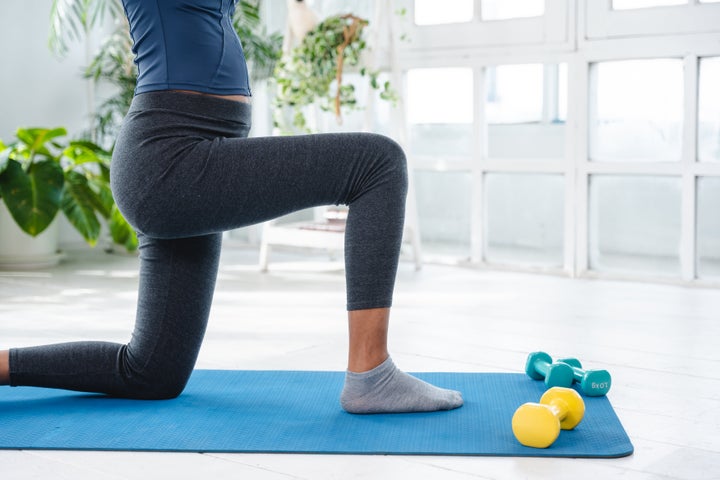
After weekly medical check-ins at the end of pregnancy, most people won’t see a health care provider until six weeks postpartum. At that point, if it looks like healing is proceeding well, they are officially “cleared” to have sex and exercise again.
Following delivery, the focus tends to shift to the baby’s health (how much are they eating, sleeping or crying?) and away from the person who gave birth. Common postpartum physical complaints such as incontinence or pain in the back, pelvis or genitals are often written off as par for the course, as though pregnancy and birth are expected to do some damage to the body.
While postpartum healing is a process, and most people need some time before they feel “back to normal,” there are things that you can do to support healing and lessen pain and discomfort.
One proactive step you can take is to make an appointment with a physical therapist, who can evaluate you for common postpartum issues and recommend exercises to prevent incontinence and pain. Postpartum physical therapy isn’t the norm in the U.S., but in other countries, such as France, it’s standard care.
Pregnancy’s Impact On The Body

There are multiple ways that pregnancy can put a strain on your musculoskeletal system. The hormonal shifts of pregnancy don’t only affect your reproductive organs.
“What happens is the joints can become a little more loose and lax,” Jenni Limoges, a physical therapist in Nevada specializing in pelvic floor issues, told HuffPost. This loosening helps your pelvis expand to make room for the baby, but it can also trigger pain from a previous back or hip injury or result in new discomfort.
In addition, as your belly grows, your body has to adjust to a new center of gravity. “It tends to pull people forward. It creates instability,” said Limoges. Your pelvis tips forward, and the muscles in your back, pelvis and hips all shift, either lengthening or shortening. Your abdominal muscles separate to make space for the baby. Even your feet change, flattening out to support your pregnant body (many people find they go up a shoe size following pregnancy).
Your pelvic floor muscles provide a sort of shelf inside your hip bones that supports all of the internal organs, including the uterus. There are three layers and nine different muscles that work in concert, Limoges explained. “These muscles help us stay dry,” she said, and play a key role in sexual functioning. The way these muscles have to stretch to accommodate pregnancy and allow for delivery can cause them to become too stiff or too loose, causing pain or incontinence (urinary and/or fecal).
“I often times hear of people saying that they want to opt for a C-section because they think this protects their pelvic floor,” said Ruba Raza, a North Carolina-based physical therapist who also specializes in pelvic floor, pregnancy and postpartum issues. However, Raza told HuffPost that you can still have pelvic floor issues following a C-section.
“Regardless of the mode of delivery, it is important to see a pelvic floor physical therapist if you are having symptoms during or after pregnancy,” Raza said.
“A lot of people do not seek out our services during pregnancy because they
assume that their symptoms will improve postpartum, but with most concerns, these can continue and even worsen if they are not addressed.”
Common Postpartum Issues
In addition to urinary and fecal incontinence, other common postpartum complaints that can be addressed with physical therapy, Raza said, include: “Sacroiliac joint pain [the sacroiliac joints link the pelvis to the bottom of the spine], constipation, low back pain, pelvic floor pain, C-section scar sensitivity, pain with intercourse and rectal pain.”

Another issue you may have heard about is diastasis recti. A line of connective tissue called the linea alba runs down the middle of your stomach and fastens together on both sides of your abdominal muscles. During pregnancy, this tissue stretches out and often separates to accommodate your growing uterus. After delivery, it generally closes back up again over the course of eight weeks or so. If it doesn’t close back up, you may notice that you continue to have a belly pouch, as though you were still pregnant. You may also have pain or incontinence.
Because movements like traditional abdominal crunches can worsen diastasis recti, it’s important to work with a knowledgeable provider who can prescribe exercises to help your diastasis recti heal.
What Treatment Looks Like
Physical therapy for postpartum issues generally involves weekly visits.
“The typical model for the pelvic floor is one-on-one for an hour,” said Limoges, adding that you should feel the results as soon as a couple of weeks in.
“I definitely expect within four to six weeks you’re seeing some improvements,” she continued.
Raza said she typically sees patients once a week for six to eight weeks, but of course, this varies based on the nature and severity of the issue they’re dealing with.
“The plan is very individualized to the patient’s concerns or symptoms,” she said. There are a multitude of exercises your physical therapist may teach you and have you practice at home.
Limoges explained that the treatment for pelvic floor issues such as incontinence depends on whether the problem is that the muscles are too stiff or overstretched and lacking in tone. With incontinence, it’s common to hear the blanket advice to do Kegel exercises (contracting the pelvic floor muscles — the ones you use to stop urination mid-stream), but these can be counterproductive if the issue is stiffness. For this reason, it’s a good idea to have an evaluation with a physical therapist before starting any exercise program to address your problem.
While a good portion of the evaluation involves the physical therapist learning what your symptoms are, and sometimes this can even be done via a remote telehealth visit, if you’re having a pelvic floor issue, an internal pelvic exam is usually necessary at some point.
“I like to tell people, ‘I’m not the gynecologist’s office, so I don’t use stirrups,’” said Limoges.
“I typically do a scan of tissue first, just to make sure everything looks OK. And then for the internal assessment, I insert my finger vaginally, and I’m checking each layer of muscles.” This internal exam allows the physical therapist to assess the muscle’s flexibility and to see if there is organ prolapse.
Your therapist will likely want to see how long you can hold a contraction of your pelvic muscles (a Kegel). The standard goal is ten seconds. They will also want to see how quickly you can contract the muscles and whether you have any pain.
While a physical therapist may recommend Kegel exercises if they find a lack of tone in your pelvic floor muscles, there are many other types of exercises they may prescribe.

Raza and Limoges discussed using breathing exercises with postpartum pelvic floor patients. Other possibilities include stretches, squats, and what Limoges called “self-tissue mobilization,” in which you apply gentle, internal pressure to the layers of muscle.
Each physical therapist stressed the importance of finding a way for a new parent to work these exercises into their day in a way that is feasible.
“I love incorporating exercises into activities that the patient is already doing,
such as adding in a pelvic floor and core contraction every time the patient completes a transitional movement or working on diaphragmatic breathing and pelvic floor relaxation while they are breastfeeding their baby,” said Raza.
Limoges also mentioned feeding/pumping as an opportunity to do Kegels or breathing exercises, as your life during those first few months tends to revolve around these moments. She recalled working with one mom caring for her newborn while homeschooling her older children. She needed exercises that she could do while standing and wearing the baby, so Limoges prescribed some wall sets and lunges she could do.
Postpartum or not, Limoges said she limits treatment to a few daily exercises that a person can work into their routine without too much trouble and works with the patients to address their most urgent concerns within the context of their lives.
A mother of twins, Limoges recalled, was having issues with urgency to urinate. “But she was running into a problem because she couldn’t get the twins in a place that she could watch them and go to the bathroom at the same time.” She padded her bathtub so she could set them safely in it to pee without leaking or holding it too long.
While your body will never return exactly to what it was before pregnancy, Limoges believes that improvement is always possible with any of these physical issues.
“My goal is to get people to 90% at least,” Limoges said. “Can you get yourself to where you’re not hunting for the bathroom or worrying about wearing a pad everywhere you go or [not] leaving your house and those kinds of things? Absolutely.”